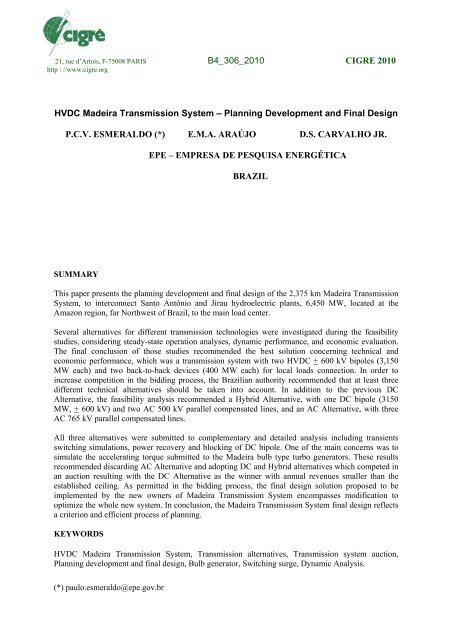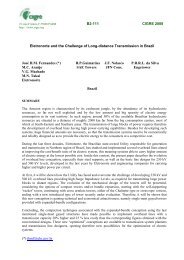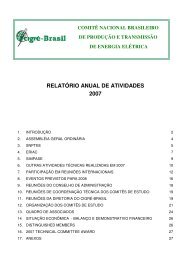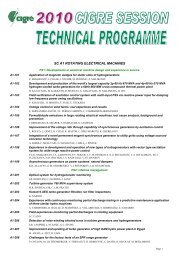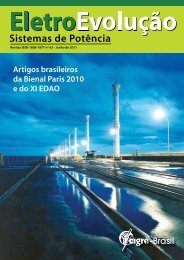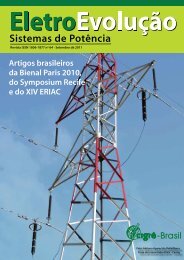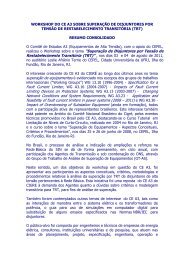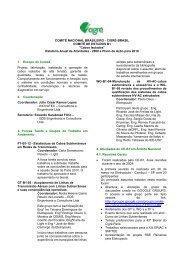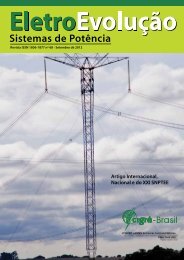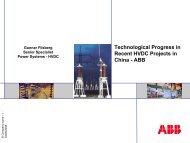HVDC Madeira Transmission System â Planning Development and ...
HVDC Madeira Transmission System â Planning Development and ...
HVDC Madeira Transmission System â Planning Development and ...
You also want an ePaper? Increase the reach of your titles
YUMPU automatically turns print PDFs into web optimized ePapers that Google loves.
21, rue d’Artois, F-75008 PARIS B4_306_2010 CIGRE 2010http : //www.cigre.org<strong>HVDC</strong> <strong>Madeira</strong> <strong>Transmission</strong> <strong>System</strong> – <strong>Planning</strong> <strong>Development</strong> <strong>and</strong> Final DesignP.C.V. ESMERALDO (*) E.M.A. ARAÚJO D.S. CARVALHO JR.EPE – EMPRESA DE PESQUISA ENERGÉTICABRAZILSUMMARYThis paper presents the planning development <strong>and</strong> final design of the 2,375 km <strong>Madeira</strong> <strong>Transmission</strong><strong>System</strong>, to interconnect Santo Antônio <strong>and</strong> Jirau hydroelectric plants, 6,450 MW, located at theAmazon region, far Northwest of Brazil, to the main load center.Several alternatives for different transmission technologies were investigated during the feasibilitystudies, considering steady-state operation analyses, dynamic performance, <strong>and</strong> economic evaluation.The final conclusion of those studies recommended the best solution concerning technical <strong>and</strong>economic performance, which was a transmission system with two <strong>HVDC</strong> + 600 kV bipoles (3,150MW each) <strong>and</strong> two back-to-back devices (400 MW each) for local loads connection. In order toincrease competition in the bidding process, the Brazilian authority recommended that at least threedifferent technical alternatives should be taken into account. In addition to the previous DCAlternative, the feasibility analysis recommended a Hybrid Alternative, with one DC bipole (3150MW, + 600 kV) <strong>and</strong> two AC 500 kV parallel compensated lines, <strong>and</strong> an AC Alternative, with threeAC 765 kV parallel compensated lines.All three alternatives were submitted to complementary <strong>and</strong> detailed analysis including transientsswitching simulations, power recovery <strong>and</strong> blocking of DC bipole. One of the main concerns was tosimulate the accelerating torque submitted to the <strong>Madeira</strong> bulb type turbo generators. These resultsrecommended discarding AC Alternative <strong>and</strong> adopting DC <strong>and</strong> Hybrid alternatives which competed inan auction resulting with the DC Alternative as the winner with annual revenues smaller than theestablished ceiling. As permitted in the bidding process, the final design solution proposed to beimplemented by the new owners of <strong>Madeira</strong> <strong>Transmission</strong> <strong>System</strong> encompasses modification tooptimize the whole new system. In conclusion, the <strong>Madeira</strong> <strong>Transmission</strong> <strong>System</strong> final design reflectsa criterion <strong>and</strong> efficient process of planning.KEYWORDS<strong>HVDC</strong> <strong>Madeira</strong> <strong>Transmission</strong> <strong>System</strong>, <strong>Transmission</strong> alternatives, <strong>Transmission</strong> system auction,<strong>Planning</strong> development <strong>and</strong> final design, Bulb generator, Switching surge, Dynamic Analysis.(*) paulo.esmeraldo@epe.gov.br
1 INTRODUCTION<strong>Madeira</strong> river hydroelectric plant projects, Santo Antônio <strong>and</strong> Jirau, generating together 6,450 MW,are the first big hydro plants at the Amazon region, far Northwest of Brazil, near the border withBolivia <strong>and</strong> Peru. The Brazilian power system interconnects 98% of the existing load, whichencompasses now local load at Porto Velho area, site of <strong>Madeira</strong>. But local load is very small, <strong>and</strong><strong>Madeira</strong> site distance 2,375 from the main loads located in the Southeast. The generation project was,then, conceived to supply local load <strong>and</strong> the energy surplus to be transmitted to a long distance. Theamount of energy <strong>and</strong> the distance, crossing different regions of the country, made such a transmissionsystem very challenging <strong>and</strong> unique to be planned <strong>and</strong> implemented.The transmission planning process in Brazil encompasses a technical <strong>and</strong> economic study to establisha reference solution, an opened <strong>and</strong> public auction <strong>and</strong> a final design to be implemented by the newowners. It initiates with a first selection of alternatives considering a broad range of conceptions interms of technologies, routes, new substations, <strong>and</strong> points of connection to the existing network.The feasibility studies starts with steady-state analysis, dynamics performance <strong>and</strong> economicsevaluation of these alternatives, which takes, to insert a new <strong>and</strong> complex transmission system in anextensive network like the Brazilan, a large amount of work <strong>and</strong> analysis. Then, for the best alternativeselected, <strong>and</strong> to assure its technical viability, additional complementary <strong>and</strong> detailed analysis is carriedon. The selected solution is the reference for a public auction when any qualified transmission agentcan dispute. The new owner can implement either the reference solution, with modification on it, oreven a new alternative. Any choice must fulfil the technical bidden process specification.This paper briefly covers the whole planning process for <strong>Madeira</strong> <strong>Transmission</strong> <strong>System</strong>, since itsconception up to the final design to be implemented.2 ALTERNATIVE SOLUTIONS IN COMPETITIONA previous paper [ 1] presented the feasibility studies for a transmission system to transfer most of thepower generated at Jirau <strong>and</strong> Santo Antônio hydroelectric plants (6,450 MW), located at the <strong>Madeira</strong>River in the Amazon region (Porto Velho 500 kV new substation), to the main load center distant2,375 km in Brazil southeastern (Araraquara 500 substation), São Paulo state, as illustrated by Figure1.PORTOVELHOARARAQUARAFigure 1 - <strong>Madeira</strong> <strong>Transmission</strong> <strong>System</strong> location1
2CE3CEThe development <strong>and</strong> the results of these analyses were carried out considering steady-state operationanalyses, dynamic performance, <strong>and</strong> economic evaluation. Several alternatives were investigated,including a number of circuit topologies, voltage levels, <strong>and</strong> different technologies such as DCtransmission, AC transmission <strong>and</strong> combinations of both. The final conclusion of those studiesrecommended the best solution concerning technical <strong>and</strong> economic performance, which was atransmission system with two <strong>HVDC</strong> + 600 kV bipoles (3,150 MW each) <strong>and</strong> two back-to-backdevices (400 MW each) for connection with a 230 kV system to feed local loads, as illustrated inFigure 2. Besides the long distance point-to-point connection, new reinforcements were planned tointegrate the Porto Velho local load with the main Brazilian transmission system.LOCAL230 kV500 kV+ 600 kV DCPORTOVELHOSTANTÔNIOback-to-backsBT2BT2 3CS-CUIABAR. ARAGUAIAOARARAQUARASoutheastNetworkbipolesJIRAUFigure 2 - DC Alternative solution for <strong>Madeira</strong> <strong>Transmission</strong> <strong>System</strong>At this stage of the transmission planning process, for the first time in Brazil, considering the largeamount of investment involved in such huge transmission system <strong>and</strong> to encourage competition, theBrazilian authority recommended that at least three different technical alternatives should be takeninto account for the bidding process of <strong>Madeira</strong> <strong>Transmission</strong> <strong>System</strong>. Then, after a large amount ofadditional studies, including all reinforcement necessary to connect the new transmission system in theInterconnected National <strong>System</strong> (SIN), three alternatives were recommended [ 2], briefly described as:DC Alternative, firstly recommended; Hybrid Alternative (Figure 3), with one DC bipole (3150 MW,+ 600 kV) <strong>and</strong> two AC 500 kV parallel compensated lines (series <strong>and</strong> shunt); AC Alternative (Figure4), with three AC 765 kV parallel compensated lines (series <strong>and</strong> shunt).LOCAL230 kV500 kV+ 600 kV DCSTANTÔNIOPORTO VELHOJIPARANAC. OESTECUIABAR. ARAGUAIASoutheastNetworkARARAQUARAJIRAUA.VERMELHAFigure 3 - Hybrid Alternative for <strong>Madeira</strong> <strong>Transmission</strong> <strong>System</strong>2
230 kV500 kV765 kVLOCALSTANTÔNIOPORTO VELHOJIPARANAC. OESTE3SCCUIABAJAURUR.ARAGUAIASoutheastNetworkARARAQUARA1SCJIRAU3SCA.VERMELHAFigure 4 - AC Alternative for <strong>Madeira</strong> <strong>Transmission</strong> <strong>System</strong>The following stage of analysis, as for any other national grid new transmission system planned inBrazil, requires the recommended feasible solution to be submitted to complementary <strong>and</strong> detailedevaluation, as described in the next item of this article. It must fulfil all technical requirements, inorder to be eligible for the competitive bidding process.3 COMPLEMENTARY AND DETAILED ANALYSISThis analysis included transients switching simulation, as energization, reclosing, load rejection <strong>and</strong>short circuit, using EMTP-ATP (Alternative Transients Program) <strong>and</strong> EMTDC programs. Foralternatives with DC bipole, power recovery after short circuits, bipole blocking <strong>and</strong> overvoltages inDC side after faults on DC line were also carried out [ 3]. One of the main concerns of the studies wasto simulate the accelerating torque submitted to the <strong>Madeira</strong> low inertia bulb type turbo generators(first ever used 83 MW hydro generator), due to fault applications at the AC transmission systemconnected to itThe network represented corresponded to 2012/2013 years, first stage of the <strong>Madeira</strong> <strong>Transmission</strong><strong>System</strong>, with a small number of generators, <strong>and</strong> 2017 year, final stage, with all generators at Jirau(46units) <strong>and</strong> Santo Antônio(44 units) hydro plants. The study was conducted with planning criteriausually adopted in Brazil, similar to those considered for the Itaipu <strong>Transmission</strong> <strong>System</strong> [ 4].DC AlternativeOperation points of the AC, <strong>HVDC</strong> <strong>and</strong> back-to-back system corresponded to the main configurationsanalyzed in the previous planning process with emphasis to the complete scenario of 2017, whichincludes the two bipoles transmitting its nominal power of 3150 MW, each.The pick value of accelerating torque resulted in 2.5 p.u. at Jirau generators, with generator nominalpower as a base, for a three-phase short circuit at the converter 500 kV AC bus in Porto Velho, asillustrated in Figure 5. For all other conditions simulated, with single or three-phase short-circuits atthe converters AC 500 kV terminals in Porto Velho or Araraquara, maximum values for acceleratingtorque were ranged between 0.7 <strong>and</strong> 2.0 p.u.3
2.0Santo Antônio3Jirau1.521.010.500.0-1-0.50.0 0.2 0.4 0.6 0.8 1.0(file 2CC600_3F_PV500_dx16_Estat.adf; x-var Domain) SA_Pacc:1-20.0 0.2 0.4 0.6 0.8 1.0(file 2CC600_3F_PV500_dx16_Estat.adf; x-var Domain) JIRAU_Pacc:1Figure 5 - Accelerating torque at Santo Antônio <strong>and</strong> Jirau after a three-phase fault at S. Antônio500 kV - DC AlternativeThe DC power recovery is limited by the AC system capacity to supply the reactive powerconsumption during the DC power transient. Figure 6 illustrates the DC power recovery at the <strong>HVDC</strong>Porto Velho rectifier after a 100 ms single phase short-circuit at Araraquara 500 kV AC bus converter.8000Potência CC (MW)8000Potência Reativa (consumo-filtros) (Mvar)5400540028002800200200-2400-2400-5000-50000.0 0.4 0.8 1.2 1.6 2.0 0.0 0.4 0.8 1.2 1.6 2.0(file 2CC600_1F_Ara_dx16_Estat.adf; x-var Domain) Pdc_elo:1(file 2CC600_1F_Ara_dx16_Estat.adf; x-var Domain) Qdc_elo:1Figure 6 - DC power recovery <strong>and</strong> reactive power at Porto Velho rectifier after a 100 ms shortcircuitin the 500 kV AC bus inverter.The DC power recovery was quite fast for short-circuits with impedance. Last than 150 ms wasnecessary for the DC power recovery to 90% of its initial value. Nevertheless, for three-phase shortcircuitwithout impedance applied to AC 500 kV bus of inverter, this time increased to 350 ms. Forthese cases was recommended that transmission agent, during project implementation, shall adjust thecontrols in order to reduce recovery time. The Porto Velho back-to-back converter has a similarperformance <strong>and</strong> the same recommendation applied.For transient switching overvoltage DC Alternative had a good performance. For all disturbancesimulated overvoltage pick values situated under expected values, as resumed at Table 1.Table 1 - Maximum overvoltages at different points of network - DC Alternative<strong>System</strong> represented Disturbance Maximum overvoltage (p.u.)Last stage, AC <strong>and</strong> DC 2 bipoles <strong>and</strong> back-to-back 1.2 to 1.45 at 500 kV networkcompleteblockedAC <strong>and</strong> back-to-back, without Back-to-back blocked1.15 to 1.45 at 230 kV<strong>HVDC</strong> bipolesLast stage, AC <strong>and</strong> DCcompleteShort-circuit applied at differentpoints of DC line1.91 at middle of DC line4
Hybrid AlternativeSince the two parallel 500 kV lines were planned to start operation two years in advance of the <strong>HVDC</strong>link, switching manoeuvres at the AC network were simulated within all segments of the 2,375 kmtransmission corridor, from Santo Antônio to Araraquara. The results showed overvoltage (2.05 p.u.phase to ground) under the admitted criterion limits <strong>and</strong> ZnO arrester energy limits not violated. Forload rejection, opening of the two lines simultaneously, overvoltages were found in the range of 2.2(without fault) to 2.8 p.u. (with fault) <strong>and</strong> a recommendation for multiple arresters columns were done.In the last stage of the Hybrid Alternative, with <strong>HVDC</strong> included, all manoeuvres <strong>and</strong> load rejections inthe AC 500 network were less severe.Accelerating torque imposed to generators resulted with pick value equal to 3.0 p.u. at Santo Antôniogenerators (generator nominal power as a base), for a three-phase short circuit at Porto Velhoconverter 500 kV AC bus. At this point of final technical analysis, as accelerating torque was apermanent concern, the support of an expert consultant was requested. De Mello[ 5] analyzed theresults of Alternatives DC <strong>and</strong> Hybrid, <strong>and</strong> had the opinion that the severity of fault torques is notunusual relative to that found in the industry.The remaining analysis with the <strong>HVDC</strong> resulted very similar to the DC Alternative, as the bipoles areidentical. This included active power recovery following short-circuits in the AC network, overvoltageat the AC network, <strong>and</strong> overvoltages at the DC lines due to short-circuit in different points of the line.Even though, there was not doubt about the feasibility of the solution appointed, the analysisrecommended for the future transmission agent to exploit reclosure operations.AC AlternativeEnergization <strong>and</strong> reclosure of the 765 kV transmission lines were simulated for the first stage ofimplementation with one single circuit from Santo Antônio to Araraquara. The results wereovervoltages (1.9 to 2.14 p.u.) <strong>and</strong> arrester energy under acceptable limits.For load rejection, final stage with all generators <strong>and</strong> the simultaneously openness of the threeparallels 765 kV lines were considered, similar to the Itaipu project in the 70s [ 4]. Table 2summarizes the main results.Table 2 - Bus overvoltage <strong>and</strong> arrester energy due to load rejection - 765 kV AC AlternativeCase Line rejectedSubsequently Max transient Temporarily MaxTerminalsingle-phase overvoltage (p.u.) overvoltage arresterrejectedshort-circuit at Fase to Fase to (at the end of energyground fase simulation) (MJ)1 Porto Velho- Porto Velho ---- 1.79 1.94 1.25 42 Ji ParanáP. Velho 1.93 2.14 - 387 ( 1 ) A. Vermelha----- 1.80 2.02 1.75 ∞7a ( 1,2 ) AraraquaraAraraquara---- 1.80 2.02 1.75 288 ( 1,2 ) Araraquara 1.93 2.16 - 579 Rio Araguaia- Água ---- 1.82 2.01 1.60 ∞9a ( 2 ) A.Vermelha Vermelha ---- 1.82 2.01 1.60 910 ( 2 ) A. Vermelha 1.93 2.35 - 4011 ( 3 ) Rio Araguaia- Água ---- 1.84 2.23 1.77 ∞11a ( 2,3 ) A. Vermelha Vermelha ---- 1.84 2.23 1.77 4412 ( 2,3 ) A. Vermelha 1.93 2.34 - 77Notes ( 1 ) - With openness of 765/500 kV transformer in SE Água Vermelha at the same time of rejection.( 2 ) - With openness of the three 765 kV lines in SE Cuiabá, 300 ms after rejection.( 3 ) - With openness of 765/500 kV transformer in SE Cuiabá.The adequacy of such criterion was reinforced by two recent triple rejections of the Itaipu 765 kVtransmission system. The last one, in November/2009, provoked one of the biggest black-out in the5
Brazilian interconnected power system, nevertheless with no equipments damages as previouslydesigned. The openness of 765/500 kV transformers connected at two substation along the 765 kVroute (Água Vermelha or Cuiabá) were imposed by the overcurrents at these transformers during loadrejection.Temporarily overvoltage resulted high, <strong>and</strong> consequently with high level of energy at arrester,imposing a prohibitive number of arrester columns (near 10, considering 7.96 MJ per column), evenwhen the openness of the lines at the opposite terminal of rejection was an operation strategy. If suchmanoeuvre is not considered energy results extremely high anyway (cases 7, 9 <strong>and</strong> 11).The analysis recommended a necessity to re-design the AC Alternative, once typical solutions tomitigate the identified problems were not applied. <strong>Planning</strong> should point out to feasible solutions withsmall risks for implementation. The AC Alternative was, then, discarded.4 TRANSMISSION SYSTEM AUCTIONDC <strong>and</strong> Hybrid alternatives competed in an auction promoted by ANEEL (Brazilian regulatoryagency) in November 2008, resulting with the DC Alternative as the winner with annual revenuessmaller (7.15% average) than the established ceiling. The Brazilian regulatory model considers aceiling annual payment for each new transmission element put in auction.In order to improve competition, ANEEL split the transmission system in parts to be offered in thatauction, as illustrated in Figure 7, for the DC Alternative, with seven different lots, including thenecessary reinforcements to accommodate the main transmission system in the national network.The bidding process resulted with different owners for pair of converters (rectifier <strong>and</strong> inverter) <strong>and</strong>DC lines. Also each one of the pair of converters was granted to different manufacturers. Theintegration of these two DC bipoles, two back-to-backs <strong>and</strong> a master control has become a challengesince then.SE Porto VelhoFiltro AC+600kV CC4x2312MCM – 2375kmSE AraraquaraLOT 11575 MVAPólo 11575MWLOT 2 LOT 41575 MVAPólo 21575MWPólo 11475MWLOT 2Pólo 21475MWAraraquara(Furnas)Filtro AC-600kV CC4x2312MCM – 2375km+600kV CC44x71,6MW Filtro AC4x2312MCM – 2375kmAtibaiaS. Antônio4x954MCM - TC - 105kmPólo 1Pólo 11575MW1475MW1575 MVA3x1250MVA1575 MVAPólo 2Pólo 21475MW1575MWFiltro AC4x2312MCM – 2375km-600kV CCLOT 3 LOT 3Jirau44x75MWCuiabá RibeirãozinhoJauru Rio Verde364 km3x(- 70/100) Mvar242kmSI1x750MVA1x750MVABack-to-back1x136 MvarP. Velho Samuel Ariq. J. Paraná P.Bueno VilhenaCoxipo400 MVA400 MVA 2x954MC M12 km 41km 150km 165km 118km 160km 354CECERio BrancoAbuna Univers.- 25/50 Mvar -25/50 MvarLOT 5LOT 7MT-120/250 MvarTrindadeItumbiaraSELOT 6Araraquara(CTEEP)305km 160km 30kmFigure 7 - DC Alternative lots offered in auction6
5 FINAL DESIGN TO BE IMPLEMENTEDThe planning final stage activity requires a demonstration from the new owners that the proposedtransmission system fulfills all technical requirements established before. In a complex transmissionsystem like the one proposed to <strong>Madeira</strong> a potential number of details have to be discussed withmanufacturers <strong>and</strong> the new owners, in order to guarantee that the final design conceived by theplanners is ready to be implemented without any constraints.According with the bidding process rules, however, auction entrepreneur winner has the freedom ofdesign optimization of the whole new transmission system, provided that its performance ismaintained equal to or better than the originally planned conceived. As a result, the final solutionproposed to be implemented by the new owners of <strong>Madeira</strong> <strong>Transmission</strong> <strong>System</strong> has some changes,such as:Operation schedule anticipation to match with generation hydro plants schedule.CCC type back-to-back converters instead of conventional type for local load, with no need ofsynchronous compensation in Porto Velho.DC transmission lines bipoles provided with All Aluminum cables instead of ACSR type.DC transmission lines divided in three sections, with distinct project, in accordance with localenvironment, as the long lines cross distinct region of the country.Change in converter filters lay-out reinforcing isl<strong>and</strong>ing conception.One of the converter stations provided with three-winding transformers instead of twowinding.Minor changes, like the smooth reactor split with main part installed at lower level voltage.6 CONCLUSIONThe planning process of the <strong>Madeira</strong> <strong>Transmission</strong> <strong>System</strong> within such amount of power to betransmitted, <strong>and</strong> the long distance crossing different regions of Brazil, was effectively a challenge. Inaddition, selection of three transmission alternative, instead of the tradition one, largely increased theamount of analysis.Even though, the feasibility studies indicated DC Alternative as the most efficient solution, thecomplementary <strong>and</strong> detailed analysis reinforced this indication <strong>and</strong> cleared recommended a necessityto re-design the AC Alternative, which was discarded.A new transmission system put in competition, with the actual rules, can contribute to reducetransmission costs, as indicated by the bidding results, with annual revenues for the new transmissionowners averaging 7.15% less than the established ceiling. And even considering a reference solutionselected by the planners, the new transmission owner had the possibility to optimize this solution <strong>and</strong>,consequently, improve its efficiency.The <strong>Madeira</strong> <strong>Transmission</strong> <strong>System</strong> final design reflects a criterion <strong>and</strong> efficient process of planning,when the best technical <strong>and</strong> economical alternative was selected by the planners <strong>and</strong> its choicereinforced by transmission agents <strong>and</strong> their financial supporters.7 ACKNOWLEDGEMENTThe authors acknowledge the participation <strong>and</strong> contributions of the Working Group memberscompounded by the main transmission companies in Brazil (Eletrobras, Furnas, Chesf, Eletrosul,Eletronorte, Cepel, Cemig, Cteep, ONS).7
8 BIBLIOGRAPHY[ 1] Esmeraldo, Paulo C. V. et all. Feasibility Studies for <strong>Madeira</strong> <strong>Transmission</strong> <strong>System</strong> - Technical<strong>and</strong> Economics Analysis, CIGRE Session 2008, paper B4-103.[ 2] Integrated system analysis for the <strong>Madeira</strong> river hydroelectric plants <strong>and</strong> reinforcements in theInterconnected National <strong>System</strong> - Reports R1 - Detailing alternatives. Report n. EPE-DEE-RE055r1, May/2008 - in Portuguese.[ 3] Carvalho Jr., Dourival S.; Esmeraldo, P.C V.; Working Group of Reports R2; <strong>Madeira</strong><strong>Transmission</strong> <strong>System</strong> - Switching Manoeuvres Evaluation, Cigrê XX SNPTEE, Recife, Brazil,2009 - in Portuguese.[ 4] Peixoto, C.A. et all. Sistema de Transmissão de Itaipu CA/CC - Sobretensões Dinâmicas eTransitórias e suas Influências nas Características dos Equipamentos, VI Seminário Nacional deProdução e Transmissão de Energia Elétrica, Camboriu, SC, Brasil, 1981.[ 5 ] Mello, F.P.; Considerations on the Capability of the AHE <strong>Madeira</strong> Bulb Type Turbo-Generatorsof Withst<strong>and</strong>ing Accelerating Torque Transients, Consulting Engineer Report, June 2008.8


